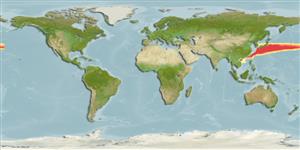Élasmobranches (requins et raies) (sharks and rays) >
Carcharhiniformes (Ground sharks) >
Pentanchidae (Deepwater catsharks)
Etymology: Apristurus: a-, Latin privative, i.e., without; pristis, from pristes (Gr.), sawyer (but here meaning saw); oura (Gr.), tail, referring to absence of saw-toothed crest of enlarged dermal denticles along upper edge of caudal fin as found in the closely related Pristiurus (=Galeus) (See ETYFish); pinguis: Latin for fat, described as having a “stout” body (See ETYFish).
Environment: milieu / climate zone / depth range / distribution range
Écologie
marin bathypélagique; profondeur 200 - 1000 m (Ref. 41248). Deep-water
Northwest Pacific: East China Sea.
Taille / Poids / Âge
Maturity: Lm ? range ? - ? cm
Max length : 83.5 cm TL mâle / non sexé; (Ref. 101563)
Body stout. Snout length in front of mouth about 1.2 times the distance between nostrils. Long anal fin, rear tip nearly reaching origin of lower caudal lobe. Greater distance between origins of pectoral and pelvic than the distance of tip of snout to origin of pectoral fin; but shorter compared to that from tip of snout to end of pectoral base. Similar to A. japonicus but differs in having distance between orbits about the length of snout in front of mouth; length of nostril about 1/2 distance between nostrils; the upper and lower labials about equal in length (Ref. 41248).
Life cycle and mating behavior
Maturité | Reproduction | Frai | Œufs | Fécondité | Larves
Oviparous, paired eggs are laid. Embryos feed solely on yolk (Ref. 50449).
Nakaya, K. and K. Sato, 1999. Species grouping within the genus Apristurus (Elasmobranchii: Scyliorhinidae). p. 307-320 In Séret B. & J.-Y. Sire [eds]. Proc. 5th Indo-Pac. Fish Conf., Noumea, 1997. (Ref. 39431)
Statut dans la liste rouge de l'IUCN (Ref. 130435: Version 2024-2)
Menace pour l'homme
Harmless
Utilisations par l'homme
Outils
Articles particuliers
Télécharger en XML
Sources Internet
Estimates based on models
Preferred temperature (Ref.
123201): 7.8 - 15, mean 10.1 °C (based on 48 cells).
Phylogenetic diversity index (Ref.
82804): PD
50 = 0.5000 [Uniqueness, from 0.5 = low to 2.0 = high].
Bayesian length-weight: a=0.00288 (0.00169 - 0.00493), b=3.07 (2.92 - 3.22), in cm total length, based on LWR estimates for this species & (Sub)family-body (Ref.
93245).
Niveau trophique (Ref.
69278): 4.0 ±0.4 se; based on size and trophs of closest relatives
Résilience (Ref.
120179): Très faible, temps minimum de doublement de population supérieur à 14 ans (Fec assumed to be <10).
Fishing Vulnerability (Ref.
59153): Moderate to high vulnerability (53 of 100).
